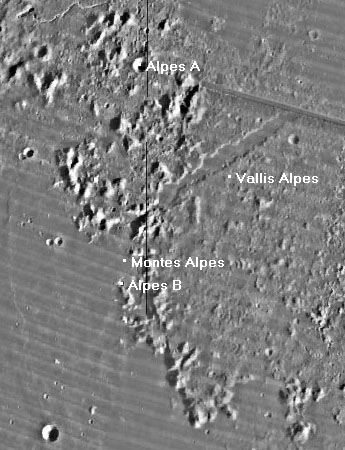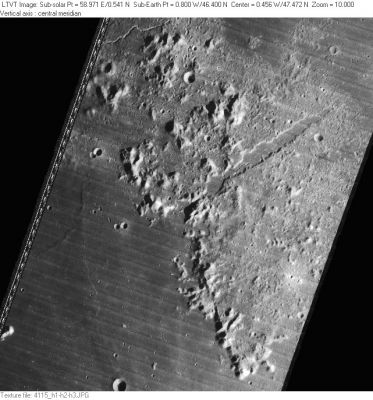Montes Alpes
Contents
Montes Alpes
(current IAU name; formerly Alps)
|
Lat: 46.4°N, Long: 0.8°W, Diam: 281 km, Height: 2.4 km, Rükl: 12 |
LO-IV-115H This aerial view of the lunar Alps extends from Rimae Plato on the north to Promontorium Agassiz on the south. The Alpine Valley is visible as the swordblade-like rift extending to the upper right. The isolated crater along the lower margin, in Mare Imbrium, is Piazzi Smyth. The sunlight peak on the left, once known as Pico Beta, no longer has an official IAU-approved name.
Images
LPOD Photo Gallery Lunar Orbiter Images
- Spectacular close-up photographs of Montes Alpes (the part east of Plato) were made by Lunar Orbiter 5; Frames 129, 130, 131, and 132. Research Danny Caes.
- Although there seems to be nothing in the LPI's Apollo Images Search for the Montes Alpes and their most southern peaks such as Promontorium Agassiz and Promontorium Deville, there ARE orbital Apollo photographs of those peaks! For example: Fairchild-Metric image AS15-M-1538 which shows these peaks at the centre of the curved horizon! (north of Aristillus). Research Danny Caes.
Maps
(LAC zone 25B1) LAC map Geologic map
Description
Description: Elger
(IAU Directions) THE ALPS.--include many hundred peaks, among which, Mont Blanc rises to a height of 12,000 feet, and a second, some distance east of Plato, to nearly as great an altitude; while others, ranging from 5,000 to 8,000 feet, are common. They extend in a south-east direction from Plato to the Caucasus, terminating somewhat abruptly, a little east of the central meridian, in about N. lat. 42 deg. One of the most interesting features associated with this range is the so-called great Alpine valley, which cuts through it east of Plato.
Description: Wikipedia
Additional Information
- Depth data from Kurt Fisher database
- Viscardy, 1985: 2.4 km
- Cherrington, 1969: 3.65 km
Nomenclature
- Named from terrestrial Alps.
- According to Whitaker (p. 209), of the many names introduced by Hevelius, Alpes is one of just ten that have survived into modern usage; and one of only four still used at the original location. Riccioli called this area Terra Grandinis. Since this the mountainous area was neither a mare nor a measured point, neither name appears in Lichtenberg's index to features on the earlier map of Tobias Mayer, later reprinted by Johann Schröter. Schröter placed Riccioli's designation on his drawing of the area, but in the text of Vol. I refers to the "Mondalpen" (Moon Alps) and "Alpengebirge" (Alpine Mountains), indicating he was aware of Hevelius' name for the formation. Use of Hevelius' designation returned to mainstream through its appearance in Beer and Mädler, who rejected Riccioli's "Terra" names. - JimMosher
- In the original IAU nomenclature of Blagg and Müller Beer and Mädler's spelling was Anglicized to Alps (unlike the present IAU, Blagg and Müller recommended astronomers in different countries use their domestic spelling of common words). The 1935 nomenclature included two lettered craters having names derived from Alps: 11-km Alps A (called Plato A(2) in Beer and Mädler)and 5-km Alps B (a previously unnamed crater) as well as the large "cleft" then called the Alpine Valley. The name Alps was apparently Latinized to Montes Alpes in the early 1960's, although that change does not appear to be explicitly mentioned in any of the IAU Transactions. - JimMosher
- This LTVT-generated diagram illustrates the current IAU-approved names sharing the primary name "Alpes" which differ from the 1935 ones only in spelling.
 The background image is the USGS's Lunar Orbiter mosaic. The dots indicate the current "official" center positions listed in the IAU Planetary Gazetteer. As it was in 1935, the IAU nomenclature within the Alpes district continues to be quite confusing, with satellite features between Alpes A and Alpes B (not labeld on this map) assigned not to Montes Alpes but rather to Trouvelot and the very distant Protagoras.
The background image is the USGS's Lunar Orbiter mosaic. The dots indicate the current "official" center positions listed in the IAU Planetary Gazetteer. As it was in 1935, the IAU nomenclature within the Alpes district continues to be quite confusing, with satellite features between Alpes A and Alpes B (not labeld on this map) assigned not to Montes Alpes but rather to Trouvelot and the very distant Protagoras.
LPOD Articles
Classic View
Charcoal Excursion
LROC Articles
Bibliography
